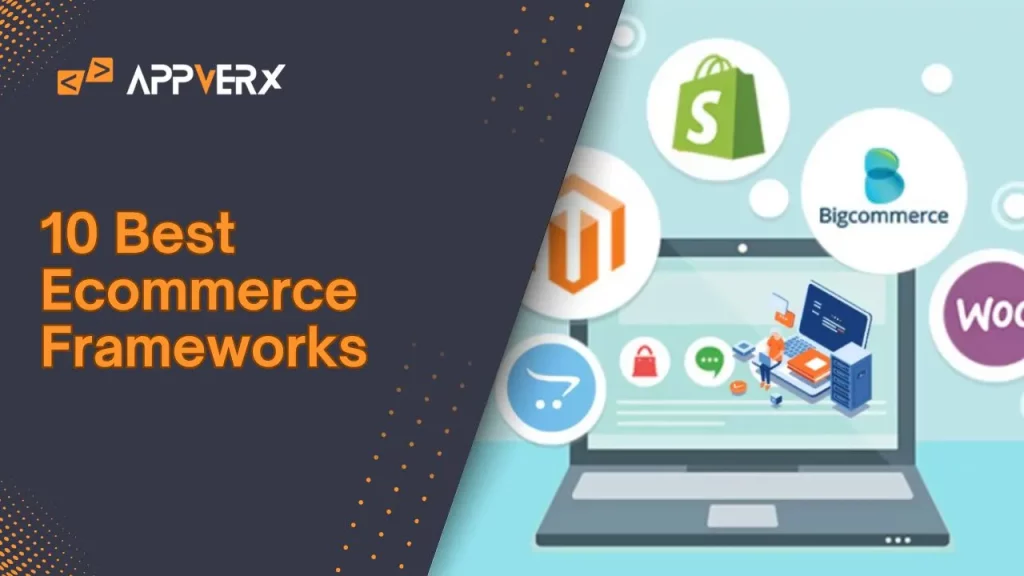In the fast-paced world of online commerce, selecting the right eCommerce frameworks is akin to laying the foundation for success. Your choice significantly impacts user experience, scalability, and overall business operations. Scalability, ease of use, and customization options are important factors to consider when making an informed choice. In this guide, we’ll explore the top eCommerce frameworks for 2023, shedding light on the diverse options available, including SaaS, Open-source, and Headless solutions.
Types of eCommerce Frameworks
SaaS (Software as a Service)
As exemplified by Shopify, SaaS frameworks provide an all-in-one solution hosted by the service provider. Beginners will find this type easy to use due to its simplicity and ease of use. However, drawbacks include high transaction fees and limited customization options.
Open-source
WooCommerce, built on WordPress, falls into the open-source category. These frameworks provide flexibility and extensive customization but may demand technical proficiency. While open-source solutions like WooCommerce empower developers, they pose challenges for less technically inclined users.
Headless Commerce
Headless commerce, a modern eCommerce approach, decouples the front and back end, enhancing flexibility and innovation. Notable frameworks like Contentful and Commercetools offer powerful solutions, allowing businesses to create tailored experiences. This method is particularly advantageous for enterprises seeking a unique and customized storefront.
Unveiling the Best eCommerce Frameworks
Shopify:
Overview: Shopify, a market leader, offers a user-friendly interface with many apps and themes. It is renowned for its ease of use, allowing beginners to set up and manage an online store efficiently. Its scalability also caters to small businesses and enterprises, while the extensive app ecosystem provides flexibility and customization options.
Pros: Known for its ease-of-use, scalability, and an extensive ecosystem of apps.
Cons: High transaction fees and limited customization options may be a drawback for certain businesses.
BigCommerce:
Overview: BigCommerce boasts robust features, making it an ideal choice for large stores with built-in B2B functionality. This platform is designed to provide a seamless shopping experience for customers while equipping businesses with advanced tools for inventory management and B2B operations.
Pros: Scalable, with robust features and built-in B2B functionality.
Cons: While powerful, it can be relatively expensive and may not be as user-friendly as Shopify.
WooCommerce:
Overview: Built on WordPress, WooCommerce provides open-source flexibility and high customization. Integrating seamlessly with WordPress allows businesses to take advantage of the content management system and e-commerce platform, offering a complete solution for online businesses.
Pros: Open-source, flexible, and highly customizable.
Cons: Requires technical knowledge, making it less user-friendly for those unfamiliar with coding.
Magento:
Overview: Magento, a powerful open-source platform, offers extensive customization possibilities with a large developer community. Tailored for businesses with specific requirements, Magento empowers merchants to create unique and feature-rich online stores with various extensions and themes.
Pros: Highly customizable, scalable, and supported by a strong developer community.
Cons: Its complexity in setup and maintenance demands significant technical expertise.
Headless Commerce:
Decoding Innovation: Headless commerce, a revolutionary approach, decouples the front end and back end, allowing unmatched customization. Notable frameworks like Contentful and Commercetools exemplify this forward-looking trend. When the presentation layer and backend logic are separated, businesses gain unprecedented flexibility and control over their user experience.
Volusion:
Overview: Positioned for small to medium businesses, Volusion offers an easy-to-use interface with built-in SEO tools and social media integration. It is an established platform focusing on affordability, making it an attractive option for entrepreneurs looking for ecommerce development.
Pros: Affordable, user-friendly, with good customer support.
Cons: Limited scalability and fewer app integrations compared to other platforms.
Shift4Shop:
Overview: Shift4Shop, a cloud-based platform, shines with robust inventory management, built-in CRM, and multi-store capabilities, catering to B2B commerce. It is an all-in-one solution for businesses seeking a comprehensive platform seamlessly integrating B2B functionalities.
Pros: Scalable, feature-rich, ideal for B2B businesses.
Cons: Complexity in setup and a steeper learning curve than some alternatives.
Kibo:
Overview: Kibo Commerce, an enterprise-level platform, targets large businesses with high-volume transactions. It boasts a personalization engine, AI-powered marketing tools, and global reach. Companies requiring advanced features and scalability can take advantage of this platform.
Pros: Highly scalable, powerful features, and global reach.
Cons: The premium has a hefty price tag and demands significant technical resources.
Salesforce Commerce Cloud (Demandware):
Overview: Preferred by major brands and retailers, Salesforce Commerce Cloud has powerful B2B and B2C capabilities, API-first architecture, and advanced analytics. With a focus on cloud dominance, it provides a secure and scalable solution for businesses aiming to deliver personalized shopping experiences across various channels.
Pros: Highly customizable, scalable, and robust security.
Cons: Comes at a premium cost, requiring extensive implementation and ongoing maintenance.
Squarespace:
Overview: Squarespace, an all-in-one platform, facilitates website and online store creation with beautiful templates and a user-friendly drag-and-drop interface. A compelling online presence without being constrained by coding complexity is easy to establish with this tool for beginners and small businesses.
Pros: A great choice for beginners, as it is easy to use and affordable.
Cons: Limited customization options may be restrictive for larger stores or complex businesses.
A Comparative Analysis: Features, Pricing, and Pros and Cons
For a more detailed understanding, here’s a table comparing the key features, pricing structures, and pros and cons of each framework:
| Framework | Features | Pricing | Pros | Cons |
|---|---|---|---|---|
| Shopify | User-friendly, scalable | Transaction-based | Easy-to-use, scalable, diverse app ecosystem | High transaction fees, limited customization options |
| BigCommerce | Robust features | Subscription-based | Robust features, suitable for large stores, B2B functionality | Higher cost, less user-friendly than Shopify |
| WooCommerce | Flexible, highly customizable | Open-source, plugin-based | Open-source, flexible, highly customizable | Requires technical knowledge, less user-friendly than hosted solutions |
| Magento | Highly customizable | Open-source, Enterprise | Highly customizable, scalable, strong developer community | Complex setup, requires significant technical expertise |
| Headless Commerce | Decoupled frontend/backend | Varies | Unparalleled customization and adaptability | Learning curve, may require specialized development expertise |
| Volusion | User-friendly, affordable | Subscription-based | Affordable, user-friendly, good customer support | Limited scalability, fewer app integrations than other platforms |
| Shift4Shop | Feature-rich, scalable | Subscription-based | Scalable, feature-rich, good for B2B businesses | Can be complex to set up, higher learning curve than some platforms |
| Kibo | Highly scalable, feature-rich | Quote-based | Highly scalable, powerful features, global reach | Expensive, requires significant technical resources |
| Salesforce Commerce Cloud | Powerful B2B and B2C | Quote-based | Highly customizable, scalable, robust security | Very expensive, requires extensive implementation and ongoing maintenance |
| Squarespace | Easy to use, affordable | Subscription-based | Easy to use, affordable, good for beginners | Limited customization options, not ideal for large stores or complex businesses |
Choosing the Right Framework:
Aligning business needs with technical expertise is key to selecting the right framework. Scalability, ease of use, and budget constraints should guide your decision. For a more in-depth understanding, leverage online resources, forums, and expert opinions to streamline decision-making.
Conclusion:
In conclusion, the significance of choosing the right eCommerce framework cannot be overstated. Developing a seamless online shopping experience sets the stage for a successful online business. By conducting thorough research, comparing options, and considering their unique business objectives, readers should be able to make informed decisions. After all, in the realm of eCommerce in 2023, the right framework is the key to unlocking unparalleled success.


